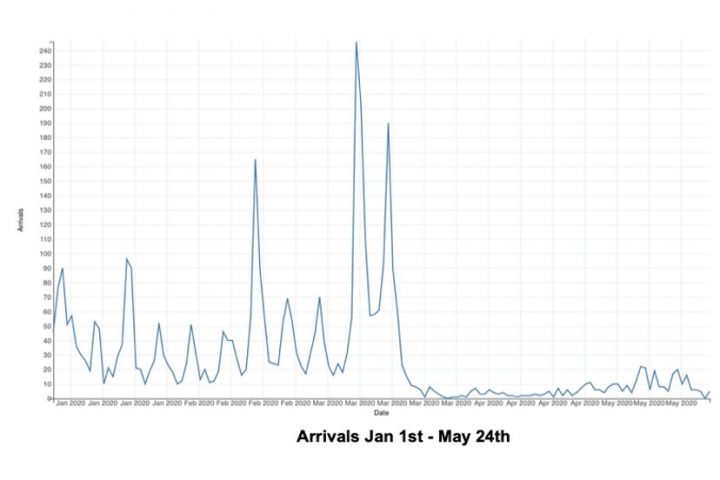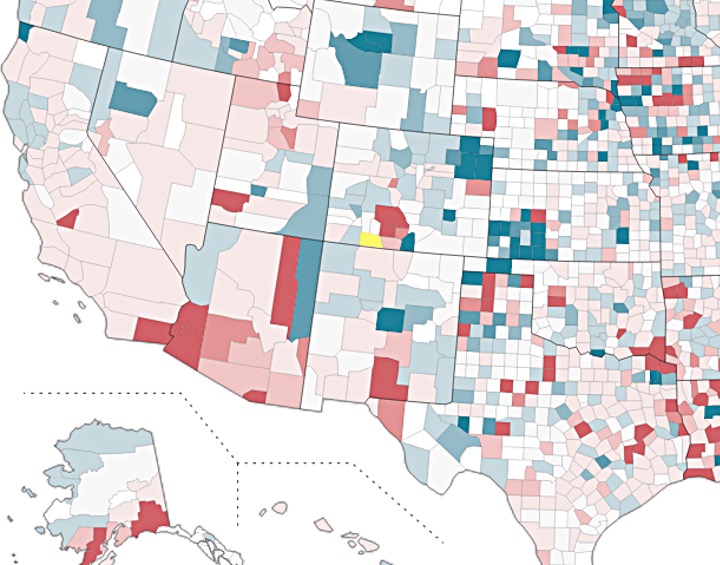SARS-CoV-2, the virus that causes coronavirus disease 2019 (COVID-19), is thought to be transmitted mainly by person-to-person contact. Implementation of nationwide public health orders to limit person-to-person interaction and of guidance on personal protective practices can slow transmission…
— from an article on the Centers for Disease Control (CDC) website, June 2020
June 2020
In June 2020, the main US agency in charge of disease control, the CDC, wasn’t yet sure exactly how the SARS-CoV-2 virus was spreading, but seemed to think it was “transmitted mainly by person-to-person contact.” The health care industry was slowly improving its methods for treating serious cases of COVID, but had not yet come across a cure for the disease, regardless of President Trump’s faith in hydroxychloroquine.
Total COVID deaths had passed the 100,000 mark on May 28.
Without a clear federal strategy for addressing the pandemic, every US state was making up its own rules — and America was fractured into its 50 individual states, with each establishing its own policies and public health orders, ordering its own Personal Protective Equipment and ventilators, each mandating mask-wearing or not, and each suffering through its own somewhat unique economic and social disaster. Each was experiencing its own rates of testing, its own rate of positivity, and its own rate of fatalities.
It felt strange, that the nation could be so polatized, politically, at a time when everyone was experiencing the same crisis.
Several states had refused to issue ‘stay-at-home’ orders: North and South Dakota, Nebraska, Wyoming, Utah, Arkansas, Iowa, Oklahoma…all traditionally ‘red’ states.
Several states had implemented relatively draconian lock-downs: New Hampshire, California, Connecticut, New Jersey, Hawaii… all traditionally ‘blue’ states.
Colorado was somewhere in the middle of the pack, in terms of the severity of its public health orders.
And another thing felt strange. Like everyone in Archuleta County, I was noticing the highway, the parking lots, and the sidewalks filling up with tourists.
Many of us in Pagosa Springs had been wondering how Colorado’s approach to the virus would affect tourism — one of the main economic sectors in Archuleta County. We knew that the local real estate market had taken a big dive (which would completely turn around during the last half of the year) and we knew that restaurants and motels were suffering. Oddly enough, we had only 8 confirmed cases of the virus through the beginning of June. (The ninth case wouldn’t be reported until June 29.) But many Pagosans lived in fear that tourists would bring the virus with them, from areas that had been hit a lot harder than Archuleta County.
Here’s Pagosa Area Tourism Director Jennie Green, speaking to the Town Council in early June:
“Luckily, we’ve had rain the last few days, but we still do have a rather significant [fire danger] situation underway… My team has put together information that we will begin to promote… Posters are being distributed, and we’re trying to get them into as many vacation rentals as we can…
“We’re currently not trying to encourage visitation. We’re also not trying to discourage visitation. Just providing helpful information…”
Ms. Green had included a couple of graphs in her Town Council presentation, showing the drop-off in visitor arrivals and also, a decline in visits to the VisitPagosaSprings.com website. One chart showed the rate of tourism visits to Pagosa.
The decline in physical visitation, beginning in mid-March, was dramatic. The drop in ‘virtual’ (online) visitation also took a hit. As shown in the charts below, the VisitPagosaSprings.com website counted about 20,000 “users” in January 2019, climbing to almost 25,000 by March — then a slight dip in April before climbing to nearly 30,000 in June 2019.
But the story was a bit different in 2020. January 2020 users once again clocked in at around 20,000, but then traffic — instead of increasing — steadily dropped off, falling to fewer than 10,000 users in April.
May 2020, however, showed a surprising growth in website users, climbing to about 17,000 — close to the 22,000 seen in May 2019. According to the information provided to the Town Council, this spike in visitor interest indicated by May 2020 user data took place without the help of an aggressive marketing campaign. The Tourism staff had “paused” their active advertising in mid-March, not knowing how the pandemic was going to play out.
So, how to explain the dramatically increased interest in May? Was it possible people are looking to visit Pagosa, all on their own, even without any ongoing promotion? (A related question which neither the Tourism Board nor the Town Council had any interest in exploring: Have we actually been wasting money on expensive government-funded tourism marketing?)
Ms. Green:
“We’re certainly seeing an increased number of visitors coming into town. Those are the folks that we don’t have to invite back. It could be second-home owners or people who are familiar with Southwest Colorado, so really the advertising efforts are really going to… it’s going to help bring folks, who might not be as familiar with Pagosa, back to town.”
Ms. Green pointed out that the marketing could be directed toward “people that the Council might be more comfortable inviting back.”
Who might that be? Those people we would be “comfortable” with… during a global pandemic?
National Geographic had been sharing some informative maps and charts, showing the progress of COVID infections and deaths across the US, and I grabbed a graphic image to share in the Daily Post.
Coronavirus in the U.S.: Where cases are growing and declining
The darker blue are the areas where the per capita rate of new infections were declining most dramatically. The darker red indicates areas where infections had been increasing. White areas were seeing no recent change in the rate…which was not the same as “no new infections”, but rather, no change in the infection rate.
Here are the general geographic areas that send the most visitors to Pagosa Springs — which is almost exclusively “drive-in traffic” as opposed to “fly-in traffic.” (Archuleta County — which was reporting no new cases — I have colored in yellow.)
Arizona appeared to be problematic…
To judge by this simple map, it looked like a toss-up, concerning the regions the Town Council might reasonably wish to begin “welcoming people back” from. A roll of the dice, you might say.
Except… maybe Arizona would be a poor choice?
All of this information was, of course, subject to change. The infection patterns were changing on a weekly basis.
At the conclusion of Ms. Green’s presentation, the Town Council didn’t want to wait a single day to start advertising again.
“I’d say, open it up now,” proposed Council member Mat deGraaf.





